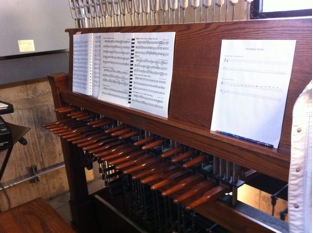Have you ever wondered how the bells in Allen Bell Tower chime? And no, there’s no tiny man with mallets jumping around from bell to bell.
What is in the bell tower is a called a carillon. A carillon is an assortment of various sizes of bells, controlled by a wooden structure similar to a piano. In order for a bell to ring, its corresponding wooden handle is pushed down.
Songs can be programmed and produced automatically, though, so no one has to sit in the bell tower staring at his watch, waiting to ring the bells so that students will know chapel is starting.
Donna King, Lipscomb’s resident carilloneur, is in charge of playing and recording music for the carillon. Most of the melodies you hear are recorded, but for special events like graduation, King plays live music.

“It really makes a difference in the sound,” King says about playing live. When the carillon plays automatically, the bells are struck from the outside rather than the inside, and so the sound loses the nuance of a live performance.
King learned how to play the carillon when Allen Bell Tower was built in 1999. Then a Lipscomb piano teacher, she was selected to learn, care for and record melodies on the carillon.
“It’s easy to learn the carillon,” King said, “but it’s hard to be good at it. A carillon is a quirky thing.”
For those desiring to play better, some universities offer majors in carillon. There are even carillon schools where students’ only option is studying carillon performance.
The carillon in Allen Bell Tower is made up of 35 bells. The smallest bell weighs 11 pounds, while the biggest weighs 550 pounds. Though this sounds gigantic, the average carillon can have much heavier bells, weighing tens of thousands of pounds.
Lipscomb’s bell tower carries a special meaning. If you’ve read the plaque on the east side of the tower, you’ll know that it was built in dedication to the late son of James Allen, a prominent Lipscomb board member.
Allen Bell Tower has become a Lipscomb landmark and serves as a reminder of the past as well as a celebration of the present.

